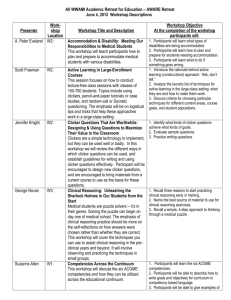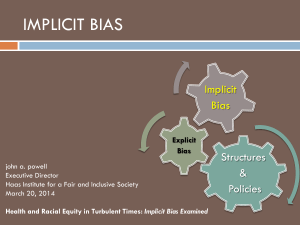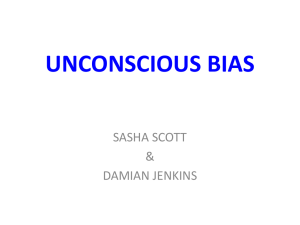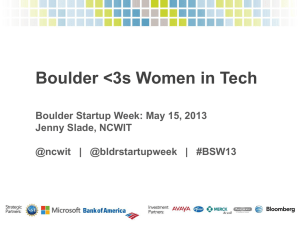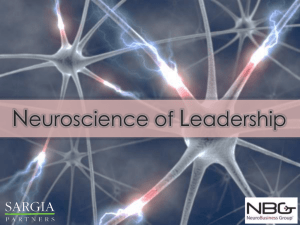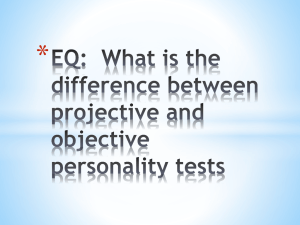PowerPoint presentation - Equity, Inclusion, and Diversity
advertisement
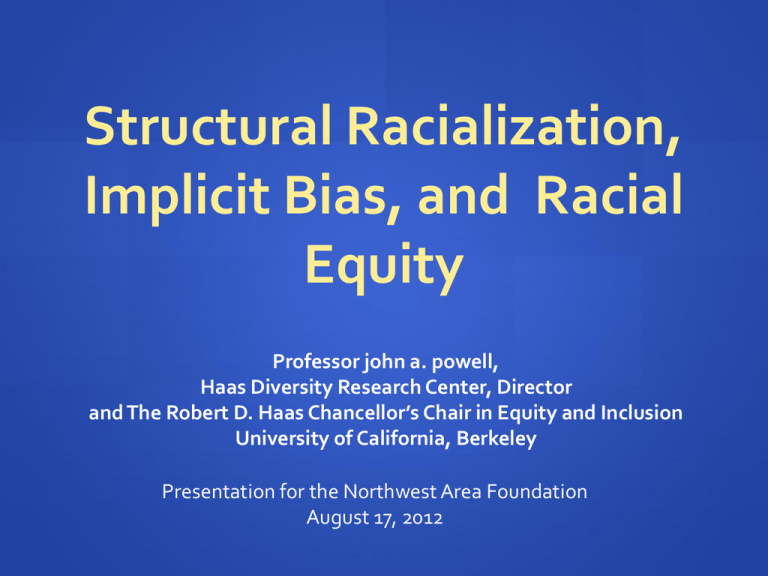
Structural Racialization, Implicit Bias, and Racial Equity Professor john a. powell, Haas Diversity Research Center, Director and The Robert D. Haas Chancellor’s Chair in Equity and Inclusion University of California, Berkeley Presentation for the Northwest Area Foundation August 17, 2012 What Are the Structures that Influence Our Society? Education Housing Economic Justice Transportation 2 Healthcare Food Communications Understanding Structures as Systems These structures are not neutral The implicit/unconscious helps to create them Structures are systems Systems are non-linear, complex, and function through feedback 3 Towards Systems Thinking Understanding structures as systems requires looking for patterns and relationships Systems thinking necessitates focusing on outcomes rather than intents or inputs 4 Differential Positioning in Structures We are all situated within structures but not evenly These structures interact in ways that produce differential outcomes 5 Differential Positioning in Structures People are impacted by the relationships between institutions and systems… Not only are people situated differently with regard to institutions, people are situated differently with regard to infrastructure …but people also impact these relationships and can change the structure of the system. 6 Differential Positioning in Structures How are women situated vis-à-vis men in the job market? How are people with disabilities positioned within transportation? How are undocumented immigrants positioned in the justice system? 7 The Circle of Human Concern Differential positioning in these structures is a way to understand who inhabits the circle of human concern as a full member and who is pushed out of it 8 The Circle of Human Concern Non-public/non-private The Circle of Human Concern Citizens Mothers Children Elderly Felons Undocumented Non-public/non-private Space Contextualizing Disparities How do we understand the resulting problems? Disparities in one part of a structure are not isolated from others They need to be contextualized in relation to other structures, such as housing, education, employment, among others 11 Mechanisms of Marginalization There are similar mechanisms of marginalization within structures that work across social groups (women, immigrants, blacks, people with disabilities, Native Americans) However, these social groups are not uniformly positioned in structures 12 Differential Racialization Structural racialization is when systems and processes produce and reproduce unequal outcomes along racial lines with or without intent It is a relational process (i.e. groups are racialized in relation to other groups) To go beyond the “Black-White” binary, we need to look at the “field of racial positions” (Kim 1999) that includes the public representation and groups relative positioning 13 Difference & Inequality An individual’s particular “co-formation” of race, ethnicity, gender, sexuality, class, language, religion, citizenship status, able-bodiedness, and geographic location marks how they are positioned in these structures as well as in concepts and stories We can always refer to structural marginalizations along multiple axes of difference (i.e. structural gender marginalization) Bacchetta, Paola. 2007 Five Faces of Oppression 1. Exploitation 2. Marginalization 3. Powerlessness 4. Cultural Dominance 5. Violence Source: Young, Iris Marion (1990). “Five Faces of Oppression,” in Justice and the Politics of Difference 15 Five Faces of Oppression Groups are differentially situated in relation to these forms of dehumanization A group may be high in one area, but low in another A group’s relational positioning may also differ in different geographies Oppressing others through Othering and dehumanization become easier to do if done a lot 16 Considering the Unconscious Mind 17 Back to the Future There is strong evidence that we are becoming more racially tolerant on a conscious level Yet, more racially anxious on an unconscious level 18 The Role of the Unconscious Mind • People are meaning-making machines. •Individual meaning •Collective meaning •Only 2% of emotional cognition is available to us consciously We unconsciously think about race even when we do not explicitly discuss it • Racial bias tends to reside in the unconscious network 19 Our Brains in Action Please state the color of the text Blue Red Green Black Green Red Blue Black Black Blue Green Red Green Green Black Blue 20 The Stroop Test And now, in Greek If you are a Greek speaker, this will show this works in any language. If you are not – how much easier it is now! But why? Remember: state the colour of the text 21 The Stroop Test Awareness Test Source: http://www.youtube.com/watch?v=yrqrkihlw-s 22 Understanding Implicit/Unconscious Bias People’s conscious values and beliefs are only part of how they process information and make decisions Many biases affecting behavior towards others reside in the unconscious mind 23 Understanding Implicit/Unconscious Bias In other words, people who consciously value racial or other forms of equality can act and make decisions based on biases without even being aware that they have any biases at all Implicit/unconscious bias is when a person’s actions are motivated by unconscious processes. 24 How Implicit/Unconscious Bias Leads to Discrimination When one holds a negative stereotype about a group and meets someone who fits the stereotype s/he may discriminate against that individual It occurs even among persons who are not consciously prejudiced 25 Priming Our environment affects our unconscious networks Priming activates mental associations Telling someone a scary story activates a frame of fear Claude Steele’s“stereotype threat”: For example, tell students about to take a test that Asian students tend to do better than whites, and the whites will perform significantly worse than if they had not been primed to think of themselves as less capable than Asians. 26 Source: http://www.eaop.ucla.edu/0405/Ed185%20-Spring05/Week_6_May9_2005.pdf Counteracting Unconscious Prejudice and Stereotypes Individuation: focus on the individual attributes of specific person versus categorization or perceiving person through filter of their social group Source: Burgess, Van Ryn, Dovidio, and Saha, J Gen Intern Med (2007); Williams, 2012 27 Social Cognition: Warmth and Competence High Pity : women, elderly, disabled Esteemed: Your own group, who you identify with Warmth Low Despised: African Americans, Undocumented immigrants Low Competence Envied: Competent, but don’t really like them: Asians High 28 Source: Douglas Massey. Categorically Unequal: The American Stratification System. New York: Russell Sage Foundation. 2007. Bringing Together Implicit Bias and Structural Racialization Implicit Bias Culture and Communication Structural Racialization Systems Approach Power Organizing The Problems of Race Neutral Poverty Programs and Policies Poverty interventions must consider the multiple underlying mechanisms of marginalization When purportedly ‘neutral’ programs and policies for poverty alleviation are overlaid on already racialized practices, norms, and institutional arrangements, it is likely to not only leave such arrangements undisturbed, but perpetuate and exacerbate them 30 Imagining a New Paradigm What is an alternative vision? A model where we all grow together A model where we embrace collective, yet differentiated solutions A vision that requires collective action to be successful 31 Towards Targeted Universalism This strategic framework starts with 32 identifying the universal goals for all in education, health, civil rights, employment, etc. Our strategies much be targeted based on the different situatedness of groups 32 Towards Targeted Universalism The framework should support the identification of specific obstacles in particular geographies and structures and stories that limit certain populations from reaching those goals 33 Towards Targeted Universalism Strategies are tailored to address the specific needs and situatedness of targeted populations They may be geographically particular based on needs and resources in different locations It is difficult to effectively benefit one group while leaving others marginalized 34 Towards Targeted Universalism Strategies often work on multiple scales based on the nature of the problem They enable networks of institutions (funders, service providers, advocacy groups) with different assets/contributions to work together through linkages 35 Creating Interventions Interventions need to focus on the following: Targeting structures and (un)conscious bias Healing the breach of exclusion created through racialized disparities Creating a process of inclusion based on fairness A focus on racial equity has broader implications for social relations and systems in our society These disparities effect the well-being of our entire society, not just marginalized communities 36 Creating Interventions If structural conditions are informed by implicit bias, then what is the organizational structure that can engage this? How do you strategically fund to address this? Analyze the problems, create multi-scalar interventions, and fund to build capacity This necessitates a flexible network, not just organizations or coalitions It also needs funding over the long term 37 Reflections on Situatedness How are we each differentially situated in structures? How do our own conscious and unconscious biases affect our philanthropic work? Where are the groups we fund situated? How are we situated vis-à-vis the groups we fund? 38 Challenges in Practice In light of differential situatedness, how are collective decisions made regarding the targeted allocation of resources to different groups to meet universal goals? What are the challenges of framing and allocating resources in this way? For example, can perceived notions of scarcity be overcome by framing investments in a particular group as also investments in the social fabric of our society? 39 Challenges in Practice While targeted universalism provides is an important framework for developing communications and informing policy and programming, it will not do all of the necessary work What other strategies need to be considered to deal with unintended consequences, unanticipated resistance, implementation problems, etc.? 40 41
